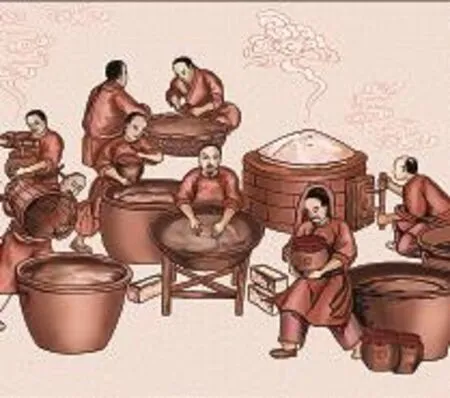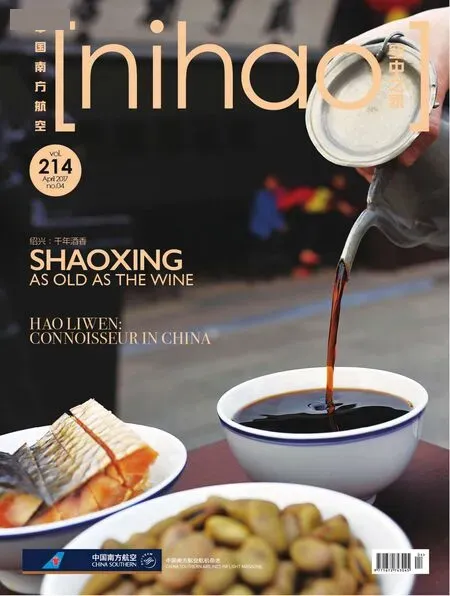The Taste of Time
The Taste of Time
From grain to liquor, a bowl of rich and savory yellow rice wine witnesses the change of time.
Text by Wang Yuanchang Photos by Wang Yuanchang & Huitu Translation by Sonia

一碗黃酒的光陰故事
The making of traditional Shaoxing yellow rice wine is complete with over 20 steps. The whole process lasts for a season and only ends in March or April when it comes to sealing and storing the vats.
Soaking: Wine was classifled into three grades based on ingredients back in the Western Han Dynasty (206 BC – 8 AD) and glutinous rice wine was considered the best. Shaoxing yellow rice wine has been made from glutinous rice since ancient times. The key is to select fresh and high-quality white glutinous rice. The criteria of high-quality glutinous rice includes a white color, full grain, nice smell, no foreign substance, and the new harvest of the year. Preparation work is completed after the rice is sieved, washed, and soaked in water for around 40 hours.
Steaming: Drained rice is steamed to 90% done. Ideally the rice is steamed till it is hard on the outside and soft inside, no raw core, loose but not sticky, and evenly done. After turning off the heat, the lid should not be removed until the rice is almost cool. The rice is scooped out of the steamer and spread on bamboo mat to cool gradually before being placed in the vats.
Vatting: Brewing yeast is added to the vats containing glutinous rice in proportion and even stirring is required.
Initial Fermentation (“raking”): Timely raking is essential to control the formation of all elements in the fermentation process. Raking indicates adding malt and the water from Jian Lake, stirring to cool off, adjusting the temperature and supplying oxygen. This is a pivotal technique in the whole brewing craftsmanship and has to be performed by seasoned brewers as it is the most crucial stage to the flnal results of brewing.
Post-fermentation: After the initial fermentation, the wort in the vat is poured into sterilized pottery jars. The jars are sealed with lotus leaves and kept at room temperature until fermentation completes by next spring. The whole fermentation process is as long as 90 days, the longest among all sorts of yellow rice wine.
Pressing and clariflcation: Fermented wort is poured into clean cloth bags and placed on a wooden winepress. Wine liquid flows out after pressing. The liquid will be kept at a low temperature for two to three days to make the wine clear.
Boiling (sterilization by heating): Wine liquid from pressing is steamed until the temperature is increased to 85 degrees Celsius. Heating stops then.
Sealing and storing: The flltered wine liquid is poured into clean jars, covered by lotus leaves and sealed with clay. The jars are kept in cool and airy places for natural ageing.

從谷米到佳釀,一碗濃郁香醇的黃酒記錄了一個又一個的冬去春來。
傳統的紹興黃酒,釀酒方式相當復雜,先后有篩米、泡米、蒸飯、攤冷、落缸、密封、發酵等20余道傳統工序。整個釀造期持續一個季度左右,直到三四月份入缸密封倉儲才算告一段落。
泡米:早在西漢時期,人們根據釀酒原料的不同,將酒分成三級,以糯米釀制的酒為上等。紹興黃酒自古以來就以糯米為原料,選擇新鮮優質的精白糯米,即米粒潔白、顆粒飽滿、氣味良好、不含雜質的上等優質糯米,同時又要是當年的新米。過篩、淘洗后,用水浸泡40個小時左右,瀝干后備用。
蒸飯:將瀝干的米上鍋蒸至九成熟離火。要求米飯蒸到外硬內軟,無夾心、疏松不煳、熟透均勻。熟后不要馬上掀鍋蓋,在鍋內把飯放至快涼時再出鍋。出鍋后打散,再攤放在竹席上自然冷卻,然后裝入大缸。
落缸:在裝有糯米飯的大缸內,按比例加入酒藥等,均勻攪拌。
前發酵(俗稱開耙): 為了掌握和控制發酵過程中各種成分適時適量的形成,必須適時開耙,即加麥曲、鑒湖水等,進行攪拌冷卻、調節溫度、補充氧氣,這是整個釀酒工藝中較難掌握的一項關鍵性技術,對酒的最終質量至關重要,必須由釀酒經驗豐富的老師傅把關。
后發酵:前發酵結束后,將缸內酒醪灌入經過殺菌的陶制酒壇中,用荷葉封口,空氣中自然放置,直至次年立春發酵結束。此工藝前后發酵時間達90天左右,是各類黃酒中酵期最長的。
壓榨澄清:將發酵好的醪液裝入干凈的布袋中,放到木榨上,利用空氣壓縮原理,榨出酒液。此時將酒液低溫放置兩至三天,使酒澄清。
煎酒(加熱殺菌):把壓榨出的酒液放入鍋內蒸,當溫度升到85度左右,即停止加熱。
封存:把濾液裝進干凈的壇子里,并用荷葉包好,外面再封上泥口,放到陰涼通風處,自然陳化后熟。

